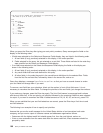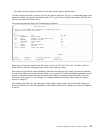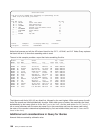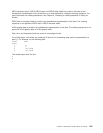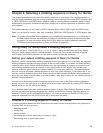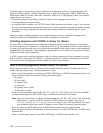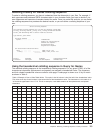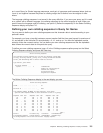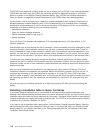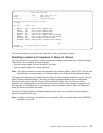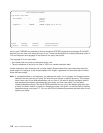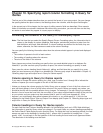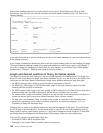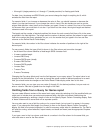
Table 3. Example of How a Code Table Works (continued). The value in the left column is the first half of the
hexadecimal value. The value at the top of each column is the second half of the hexadecimal value. The lowercase
ainthistableisat’81’X and the uppercase A is at ’C1’X. This is an example, a real table contains all the
alphanumeric and special characters.
0123456789ABCDEF
C A
D
E
F
When you use the hexadecimal collating sequence, the characters in a code table are ordered by
ascending hexadecimal values. An advantage of hexadecimal collating is that it distinguishes between
uppercase and lowercase letters.
For CCSID 37, the default for English language systems, the hexadecimal collating sequence is:
blank
miscellaneous characters, such as.+&%)
a through r
(tilde)
s through z
{
A through I
}
J through R
\
S through Z
0 through 9
To see what the hexadecimal collating sequence looks like, select option 3 (Define a collating sequence)
on the Select Collating Sequence display and press the Enter key. The Define Collating Sequence display
appears. Press F14 (hexadecimal sequence). Query for iSeries shows you the characters and their
sequence numbers in the hexadecimal collating sequence.
Each character with a hexadecimal value in the range ’40’Xto’FE’X is listed. You can use the page keys
to page through the list of characters. Press F11 to show the hexadecimal value of each character under
the Hex column. Use F12 to return to the Select Collating Sequence display.
If hexadecimal collating is selected, the minimum and maximum values saved in summary-only output to a
database file may differ from the corresponding values in a printed or displayed report, even though the
same job CCSID is used to run the query. This happens only if values for a minimum or maximum field
are converted to the job CCSID in order to be printed or displayed.
Using the language collating sequence for your country in Query for
iSeries
You may want to select the collating sequence provided by Query for iSeries for your country so that
character data is sorted in a more useful order for your language. In Great Britian and the United States,
the collating sequence provided (in addition to hexadecimal) is Query for iSeries English. In this sequence,
114 Query for iSeries Use V5R2



